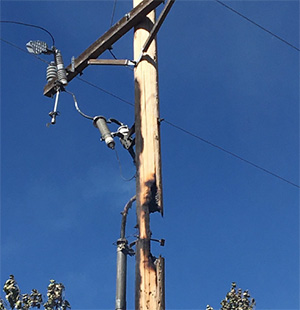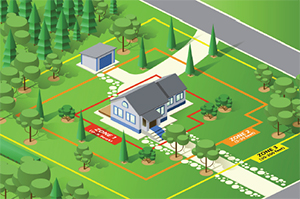Wildfire Mitigation
The Southwest region encompasses diverse ecosystems, reflecting a broad range of climate conditions, including the hottest and driest climate in the United States.

Wildfire Mitigation Plan
Climate change is producing conditions ripe for wildfires, tipping the scales in favor of the dramatic increase in the large wildfires seen in recent years. Snowpack is melting earlier as winter and spring temperatures rise. Summer temperatures are rising as well, with the number of extremely hot days steadily increasing, creating more days where forests and grasslands are dried and prone to burning.
Fire mitigation plays an essential role in SSVEC operational practices. Over the years, SSVEC has adopted several wildfire mitigation programs to adjust to environmental changes and has incorporated new technological advances and improved operational practices to further mitigate the potential for utility-caused ignitions.
For SSVEC, which aims to protect public safety and preserve the reliable delivery of electricity, wildfire mitigation is without question a top priority. While an electric utility can never entirely eliminate the risk of fire, SSVEC is committed to taking practical actions to reduce the devastation that a wildfire could bring to the people and communities we serve. This Wildfire Mitigation Plan lays out the steps we are taking to do so.
Purpose
Reducing the risk of utility-caused wildfires plays an essential role in SSVEC’s operational practices. Its existing policies, programs, and procedures, as well as the incorporation of emerging technologies, are intended to directly or indirectly manage or reduce the risk of utility-related wildfire. Additionally, SSVEC’s WMP helps mitigate damage to its facilities from all wildfires, regardless of the cause.

SSVEC believes the strategies and activities described in the WMP, with associated goals and metrics, are a practical and effective approach to reducing fire-related risk for SSVEC’s members in the near-term and will allow for refinement and improvement over time. As the Coop gains experience implementing the WMP’s mitigation programs, and as new information emerges, SSVEC will evaluate, enhance, and refine its practices.
The WMP describes vegetation management, asset inspection and maintenance, equipment upgrades, restoration of service processes, and community outreach efforts. It also addresses the unique features of SSVEC’s service area such as topography, weather, infrastructure, grid configuration, and potential wildfire risks. Additionally, it spells out plan ownership, performance metrics, deficiency identification, and the plan’s audit and approval process
Defensible Space & Community Outreach
Fuel reduction projects and vegetation treatments have been identified as an effective means of mitigating wildfire hazards. Each year, wildland fires consume hundreds of homes in the Wildland-Urban Interface, but studies show that as many as 80% of the homes lost to wildland fire could have been saved if their owners had only followed a few simple fire-safe practices.

“Defensible Space” is often defined as an area around a home where the flammable vegetation is modified and maintained to slow the rate and intensity of an advancing wildfire. In practice, this is an area 30-100 feet around a structure cleared of flammable brush or vegetation. Projects of this type include fuel breaks, thinning, pruning, and landscape modifications. These improvements can provide firefighters the much-needed room to operate while also protecting the forest from a structure fire.
SSVEC encourages its members to take proactive measures to safeguard their homes from wildfire and prepare for emergency events. To help create an awareness of fire danger in the service area and what homeowners can do to minimize it, SSVEC provides information on prevention and mitigation on its website and social media (Facebook and Twitter).
Please contact your local SSVEC office for more information and visit the Quick Links provided on this page for more information and tips.
